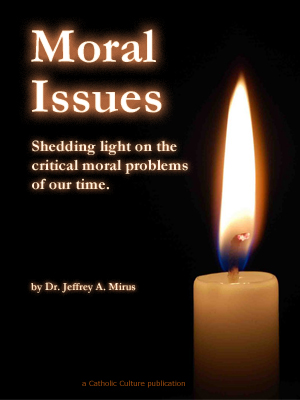Ratzinger’s Gift: Faith-Filled Exegesis
By Dr. Jeff Mirus ( bio - articles - email ) | Mar 29, 2011
Perhaps the most important thing about Pope Benedict XVI’s second volume, Jesus of Nazareth: Holy Week, is that it raises the bar for Biblical exegesis. Scholars may be shocked by this statement, but I’ll say it again. Benedict XVI is giving us a remarkable example of how reading, reflecting and commenting on Sacred Scripture should be done.
Before explaining exactly what I mean, it may be helpful to review the Magisterial status of the book. Simply stated, this is not an act of the Magisterium. It possesses no ecclesiastical authority. As Benedict himself said in the foreword to the first volume: “It goes without saying that this book is in no way an exercise of the magisterium, but is solely an expression of my personal search ‘for the face of the Lord’ (cf. Ps 27:8). Everyone is free, then, to contradict me” (pp. xxiii-xxiv). Whatever impact the grace of office has on Benedict the writer, it is not the impact of Authority. That is why I have entitled this essay “Ratzinger’s Gift”.
But it is precisely this raising of the bar in Scriptural exegesis that constitutes Ratzinger’s great gift. Some have suggested that the Pope has revived “lectio divina”, the traditional habit of reading Scripture prayerfully to seek the joy and nourishment of God’s presence in His word. But when you or I engage in lectio divina, it does not generally involve attention to the original languages, a study of what other great commentators have written, and the deliberate unraveling of obscure and possibly even disputed themes. These things are the work of exegesis (the critical explanation or interpretation of a text).
However, one of the problems that has afflicted Scripture studies during the intense and progressive secularization of academia over the past two hundred years is that exegesis has been so frequently set against lectio divina. Whereas the Fathers of the Church seemed to be able to combine the two, modern figures have found this exceedingly difficult. The difference, in most cases, has been a matter of both faith and professionalism. Many commentators have not approached the Bible with any significant faith in its Divine inspiration; and even believers have been constrained by their professional “duties” to ignore the enormous benefits of faith in their studies.
The result has been the dissociation of scholarship from lectio divina, as if the two are incompatible or even opposed. One of Joseph Ratzinger’s greatest gifts to the Church is his demonstration that this is not the case, to show that a genuine scholarly inquiry under the light of Faith yields abundant fruit in an understanding of the text that is at once more thorough and more profound.
Benedict’s new volume demonstrates this achievement repeatedly. In Chapter 1, he explores textual and historical data to penetrate the episode of the cleansing of the Temple (Mark 11), and to demonstrate how Jesus has become the new Temple. In Chapter 2, he carries this theme forward, incorporating the work of historians and exegetes to show that the Christian community was so reoriented to Christ as the foundation of its relationship with God that it was unfazed by the destruction of the Temple in AD 70—a destruction which fundamentally altered Judaism. Also in this chapter is a deep examination of the so-called eschatological discourse, the meaning of the end times and the intervening “time of the Gentiles.”
In Chapter 3, the Pope explores the washing of the feet. In the context of ancient philosophy, he explains how Christ’s self-giving marks a new kind of descent from the Divine to the human. Unlike the Divine emanations of the philosophers, which return to God by shedding the material, Christ both embraces and purifies human nature. Thus the way of self-emptying and martyrdom is a way not of escaping creation but of restoring all of creation to the Father.
And in Chapter 4, Benedict examines the specific wording of the high-priestly prayer of Christ, explicating through its long exegetical history key themes of eternal life, sanctification in truth, and making God’s name known, so that all may be one. His exploration of this oneness as rooted in truth and mission leads inevitably to apostolic succession, Scripture, and the Creed—that is, to the constitutive elements of the visible Church.
Throughout these rich treatments we find that Benedict must unlock a layered text in which Our Lord frequently expresses Himself in Old Testament figures, images and even quotations. This fact alone gives new relevance to the history of the Jewish people, to an analysis of the OT texts, and to the trajectory of the Divine Plan over time.
My point is that at every turn Benedict pulls in whatever is relevant. It might be linguistic analysis or the redaction of the early texts; it might be ancient history or the teaching of various philosophical schools; it might be seminal insights from past commentators, both Catholic and Protestant. Always there will be a close reading of the text itself in light of its antecedents in the Old Testament, and of its thematic resonance in other portions of the New. And in the background, we see Benedict’s judgments silently illuminated by the analogy of Faith—the fact that Scripture, Tradition and the Magisterium of the Church are all informed by the same Holy Spirit, and so must point together to the same Truth.
Many of the Fathers and Doctors of the Church have addressed Scripture in this way as well, not because they were professional exegetes, but because they were learned persons, often even scholars, who brought whatever they knew to bear on improving our understanding of Christ and of the Scriptures which speak of Him. Benedict not only recognizes this great tradition but alludes to its necessity in the foreword to the second volume when he explains that God works through an entire community, looking backward and forward, in inspiring the full meaning of the Biblical text (see my earlier comments, Benedict’s Second Volume and the Historical Critical Method).
Ratzinger’s gift is to show how even modern scholars (of which Pope Benedict XVI is obviously one) can fruitfully explore everything that relates to the text in a way that is not only compatible with but actually inspired by their Faith. In the Pope's own words, he has attempted “to develop a way of observing and listening to the Jesus of the Gospels that can indeed lead to a personal encounter and that, through a collective listening with Jesus’ disciples across the ages, can indeed attain sure knowledge of the real historical figure of Jesus” (vol II, Forword, p. xvii).
All comments are moderated. To lighten our editing burden, only current donors are allowed to Sound Off. If you are a current donor, log in to see the comment form; otherwise please support our work, and Sound Off!
-
Posted by: Lahrye -
Mar. 30, 2011 1:22 PM ET USA
I am astounded by your manner of providing to the reader Pope Benedict XVI's "gift" to show a way to fruitfully explore everything that relates to text in a way compatible to actually inspire the scholars faith, as well as opening my mind to this manner to broaden my faith formation as well. Thank you for opening up the Pope's second volume to stir up my inquisitive faith to open my copy to begin exploring his 'gift' on my Lenten journey.








